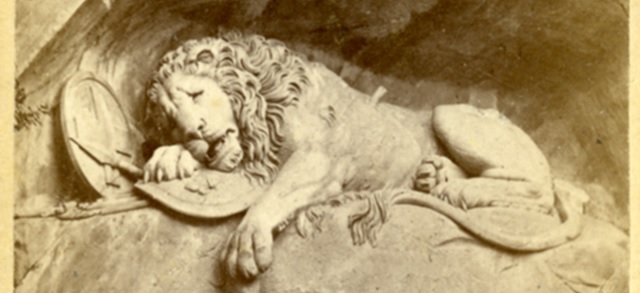
Monuments Class Projects
Architect/Sculptor of Monument
Pierre François Léonard Fontaine (1762-1853) and Charles Percier (1764-1838)
Preview

Identifier
33a
Medium
photograph, carte-de-viste
Keywords
Arc de Triomphe du Carrousel, Napoléon, Quadriga, Louvre, Triumphal Arch, Neoclassicism, Horses of St. Mark, Tuileries, Napoleonic Wars
Physical Dimensions
4 x 2.5"
Date of Publication
c. 1860-1890
Name of Monument
Arc de Triomphe du Carrousel
Date of Completion or Dedication of Monument
1808
City of Monument
Paris
Location within City
Jardin du Carrousel
State/Province of Monument
Île-de-France
Country of Monument
France
Description
The Arc de Triomphe du Carrousel was commissioned by Napoleon I to celebrate his victories. Its construction was directed by the architects Fontaine and Percier and completed in 1808. The quadriga, a chariot pulled by four horses, sits on the top of this monument and symbolizes the triumph of Napoleon's armies. Originally built for the entrance to the since destroyed Tuileries Palace, this neoclassical arch now remains in front of the Louvre.
School of Art/Architecture
Neoclassicism
Publisher
Unknown
Digital Date
2-7-2025
Copyright
Physical copy of the carte-de-visite is in the public domain. Digital copy scanned by Rod Library ©2025 Rod Library, University of Northern Iowa.
Creative Commons License

This work is licensed under a Creative Commons Attribution-NonCommercial 4.0 International License
File Format
image/jpeg



Comments
In Paris, the Arc de Triomphe du Carrousel stands as a monument symbolizing the triumph of Napoleon’s armies in 1805. Napoleon (1769-1821) wanted to commemorate his victories and troops, so he commissioned an arch to honor them and their success. Architects Pierre Fontaine (1762-1853) and Charles Percier (1764-1838) directed the construction of this monument, taking inspiration from Rome’s Arch of Septimius Severus. Although originally intended as the entrance to the Tuileries Palace, the arch remains after the palace was destroyed by a fire in 1871. It is 63 feet tall, 75 feet wide, and 24 feet deep.
On each side of the Arc de Triomphe du Carrousel are bas-reliefs, each depicting events of Napoleon's campaign. On the Louvre side, bas-reliefs portray “The Surrender at Ulm” (1805) by Pierre Cartellier (1757-1831) and “The Battle of Austerlitz” (1805) by Antoine Esparcioux (d. 1840). Pierre Cartellier taught in Paris at the École des Beaux-Arts, and was part of the Legion of Honor and the Institut de France which are highly prestigious. The Rue de Rivoli side of the arch shows “Napoleon bringing back the King of Bavaria” (1805) created by Claude Michel, Clodion, (1738-1814), who also sculpted “Napoleon entering Munich” (1805). Clodion won the “Académie Royale de Peinture et de Sculpture” grand prize in 1759. Facing the Tuileries Garden is “The Meeting of the two Emperors” (1807) by Claude Ramey (1754-1838), revealing Napoleon I meeting Russian Emperor Alexander I (1777-1825). Ramey studied at the Ecole de Dessin in Dijon. Louis-Pierre Deseine’s (1749-1822) “Napoleon entering Vienna” (1805) can be seen next to Ramey’s relief. Deseine studied in Rome after winning the first prize at the Académie Royale similar to Clodion. Facing the Seine River, “The Peace of Pressburg” (1805) is found, carved by Jacques-Philippe Le Sueur (1759-1830). All of these bas-reliefs are represented in Neoclassical style and carved out of rose marble.
Neoclassicism began in the 18th century, imitating art of ancient Rome and Greece, and faded after the mid 19th century. Neoclassical art is a simple and realistic art style. It strives for universality, idealism, harmony and clarity. Neoclassical works follow a symmetric and mathematical style, resembling styles from the era of classical antiquity. It was a response to the decorative Rococo style from early 18th century art.
During Napoleon’s reign, Fontaine and Percier together created a subsection of neoclassical art called “Empire Style”, specifically for interior decoration. The two architects first met in Paris and went on to study architecture together in Rome becoming inseparable. Napoleon's empress Josephine took notice of their work and commissioned them to redo her Château de Malmaison (1800–02). Over time the Bonapartes became their main patrons, hiring them to remodel many palaces and buildings. This is what led them to design the Arc de Triomphe du Carrousel.
Crowning the Arch is a four-horse chariot, commonly known as a quadriga, a symbol of victory and a stunning sculptural piece facing the Louvre Museum. The quadriga was popular in Ancient Rome, used for racing four horses attached to a chariot. Originally the ones on the arch were the famous Horses of Saint Mark from Venice. Venice had looted these from the Hippodrome of Constantinople in 1204. They were later stolen from Venice by Napoleon in 1797. The horses are thought to have been created in Ancient Greece or in Rome’s classical era. In 1815, the horses were returned to Venice and copies took their place on the top of the arch.
Today, the Arc de Triomphe du Carrousel carries on with a sense of pride and is a symbol of victory for France.
Originally a royal garden, the Tuileries Gardens (1564) is now a public park behind the Arc de Triomphe du Carrousel. In the late 1600s the king's gardener André Le Nôtre (1613-1700) took responsibility for maintaining the garden and is now credited with its design. Here in 1793, the Olympiad of the Republic was created.
Bibliography
The Editors of Encyclopaedia Britannica. "Charles Percier and Pierre Fontaine". Encyclopedia Britannica, 1 Sep. 2024, https://www.britannica.com/biography/Charles-Percier.
“[Arc de Triomphe Du Carrousel] (1 of 2) - UWDC - UW-Madison Libraries.” Wisc.edu, search.library.wisc.edu/digital/AIC6NHWVHWKP4T8Q.
G. Massiot & cie. “Arc de Triomphe Du Carrousel: Overall View from Front.” Marble: Museums, Archives, Rare Books & Libraries Exploration, 11 Dec. 2023, marble.nd.edu/item/x633dz04439.
Huguenaud, Karine. “Arc de Triomphe Du Carrousel - Paris.” Napoleon.org, Fondation Napoléon, 31 Dec. 2000, www.napoleon.org/en/magazine/places/arc-de-triomphe-du-carrousel-paris-2/.
Koestel, Élodie. “Conservation Treatment on the Arc de Triomphe Du Carrousel.” Le Louvre, 11 July 2023, www.louvre.fr/en/explore/life-at-the-museum/conservation-treatment-on-the-arc-de-triomphe-du-carrousel.
Stilo, Aelius. “The Horses of St. Mark’s.” Uchicago.edu, 2024, penelope.uchicago.edu/encyclopaedia_romana/circusmaximus/sanmarco.html.